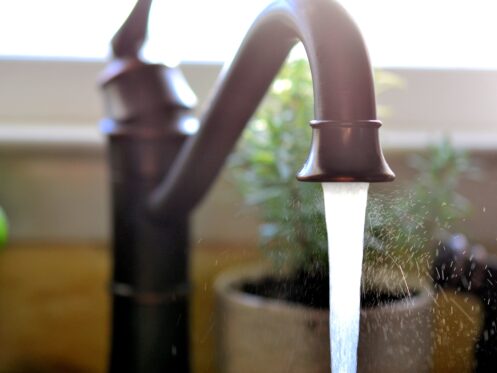Utility sinks are large, deep, versatile fixtures designed for practical uses within the home. These plumbing fixtures are suitable for a range of projects that demand durable and spacious basins, and they can also help make cleaning and organizing more cohesive and efficient.
Traditionally, most people associate utility sinks with laundry rooms or washrooms. In fact, colloquial terms for utility sinks include laundry sinks, mop sinks, or wash basins. However, the unique design of utility sinks means that they offer a host of practical applications throughout your house.
These applications include kitchens, garages, basements, sheds, workshops, and any other areas that require heavy-duty chores or cleaning activities. This in-depth look at the versatile usage, features, and installation considerations for utility sinks can help you make an informed decision about adding one to your home.
What Are the Various Uses for Utility Sinks?
The most familiar function of a utility sink is to provide adequate space for laundry-related tasks. This fixture provides enough room for presoaking heavily soiled garments or pretreating stained clothes. It also offers generous space for rinsing or soaking larger items like curtains, drapes, comforters, blankets, or other bedding.
You can also use a utility sink to hand-wash delicates more efficiently and then hang them over the fixture to air dry. Plus, in some laundry rooms, the utility sink doubles as a discharge drain to help prevent washing machine debris from ending up in your pipes.
But in addition to laundry duties, this convenient fixture can offer other practical applications throughout your property. Possible types of utilization include kitchen prep, gardening upkeep, arts and crafts projects, pet care, garage and workshop tasks, and custodial duties.
Kitchen Applications
Installing a utility sink near your kitchen is a great way to complete extensive food preparation or efficiently fulfill culinary ambitions. For example, the sink can come in handy when you’re cooking large amounts for holiday gatherings or meal prep for the week. You can use a utility sink along with a drain board to thoroughly wash vegetables or clean fish.
If you need to wash large pots or pans, the deep basin of this type of sink is the perfect way to soak dishware without cluttering tables or counters. Similarly, utility sinks offer enough room to safely scrub the grease and grime off oven racks, grills, or drip pans.
Gardening Applications
A utility sink is an invaluable resource for any type of gardening. You can use the fixture to water plants or rinse dirt and mud off flowerpots or gardening tools. These sinks are large enough to safely clean or polish outdoor supplies like clippers, shovels, pruners, or rakes.
Pet Care Applications
Households with pets can count on utility sinks to help keep living spaces sanitary and hygienic. With their commodious basins and sturdy construction, utility sinks can accommodate even the largest breeds of dogs for washing and grooming. You can use the sink to rinse soap or shampoo and insert a drain strainer to easily catch any shed hair. Many utility sinks are compatible with sprayer attachments that make it easier to bathe other types of pets such as cats or even horses.
Arts and Crafts Applications
Whether you are into painting, sculpting, or pottery, the utility sink is a must-have plumbing fixture for your workshop. This fixture makes it easy to rinse stubborn dry paint from brushes, wash out paint palettes, or mix and stir art supplies.
For households with children, the utility sink is an indispensable resource after working with crafts. It makes a convenient station for washing off glue, finger paint, or glitter. With a utility sink, you never have to dread projects like papier-mâché, modeling clay, or tie-dye again.
Garage Applications
Installing a utility sink is a practical upgrade for most garage types. In the garage, this fixture represents a dedicated area for quickly removing grease or oil from car accessories or automotive parts. It can also help prevent you from tracking dirt or grime into your home’s interior after completing mechanical work.
Sports and Recreation Applications
Utility sinks are ideal wash stations following sporting events or recreational activities. Often installed in mud rooms, these sinks allow home occupants to rinse dirt, mud, sand, or grass from their footwear before entering the house. This practice is a great way to preserve carpets and flooring while keeping your home pleasant-smelling and hygienic.
Custodial Applications
The utility sink’s deep basin also makes it easier to conduct a deep cleaning of your home. Use this fixture to manage bleach and disinfectants, fill or empty mop buckets, or safely dispose of liquid waste. You can also use the basin to create a soapy solution to thoroughly clean the largest appliances like refrigerators, freezers, or stoves.
Beneficial Features of Utility Sinks
Utility sinks have several features that distinguish them from ordinary fixtures. These features typically include heavy-duty construction and materials, reinforced walls, sloping bases, and advanced faucet configuration. Understanding these characteristics can help you and your plumber choose the best fixture model for your home.
Heavy-Duty Construction
Heavy-duty construction is an important attribute that allows utility sinks to accommodate the capacity necessary for vigorous tasks. Popular construction materials for these fixtures include stainless steel, cast iron, composite granite, porcelain, and fiberglass. A plumber can help you choose the best material for your installation needs.
For example, a stainless-steel utility sink can work well in a kitchen due to its antimicrobial properties, corrosion resistance, and attractive appearance. Composite materials are popular for sinks in mud rooms because they are stain-resistant and unlikely to crack or chip. Proper utility sink construction can also include an aerator spray head to regulate water pressure and water flow as well as a drainage hole that enables easy cleaning.
Reinforced Walls
Regardless of the construction material used, most utility sinks have reinforced walls. This feature helps such fixtures accommodate rigorous activities without warping or rupturing. Reinforcement stabilizes the installation and increases the likelihood that your fixture reaches its full life expectancy.
Sloping Base
When choosing a utility sink, you may notice that your model has a slanted or contoured base. This attribute encourages proper water flow and drainage when necessary. It also reduces the risk of stagnant water pooling at the bottom of your basin.
Advanced Faucet Configuration
Utility sinks often come with extra faucet holes designed to accommodate unique configurations like sprayer attachments, side sprayers, or swivels. Depending on the piping in your house, your plumber may install a wall-mounted faucet behind the sink or a deck-mounted faucet with its own base connected to the floor.
Important Considerations for Utility Sinks
Experts recommend hiring a professional to install and maintain your utility sink to avoid unnecessary damage to your piping infrastructure or plumbing system. The professional process includes establishing the right plumbing connections and completing routine maintenance to ensure optimal performance.
Establishing Proper Connections
During the installation process, the plumbing may need to locate connections and ensure that your designated area has adequate space and stability for your new utility sink. Fixtures typically mount on the wall, base cabinet, or floor.
Some installations require a professional to cut the existing piping and add fittings or connectors. For safety reasons, don’t attempt this yourself. A plumber can set up the fixture correctly and test the connections to ensure leak-free installation.
Regular Fixture Cleaning
Although utility sinks are durable, they still require consistent cleaning to prevent the accumulation of dirt, grime, and soap residue. Consistent cleaning helps reduce the risk of long-term stains and also helps prevent the buildup of debris that can eventually clog your bottom drain.
Routine Plumbing Maintenance
As with any plumbing fixture, utility sinks require routine maintenance to ensure peak performance and longevity. During a maintenance session, a professional can check for obstructions and diagnose any water-flow issues. A plumber can correct slight damage before it escalates into the need for major repairs and also provide viable suggestions for common plumbing issues. For example, if you live in an area with hard water, the plumber may offer installing a water softener to reduce mineral buildup in your fixtures and pipes.
Contact Us Today
Installing a utility sink is a sensible choice with opportunities for usage far beyond laundry day. Our experts are here to help implement the best option for you. 3 Mountains Home Services offers sink installation services for homes in Milwaukie, Oregon and surrounding areas. We can install or upgrade faucets and fixtures everywhere in the home from kitchens to basements. Our plumbers also offer troubleshooting and pipe repair. In addition to sinks, we can evaluate your water lines, sewer lines, or gas lines. We also work with appliances like water heaters or sump pumps.
Contact 3 Mountains Home Services for all your plumbing needs!


